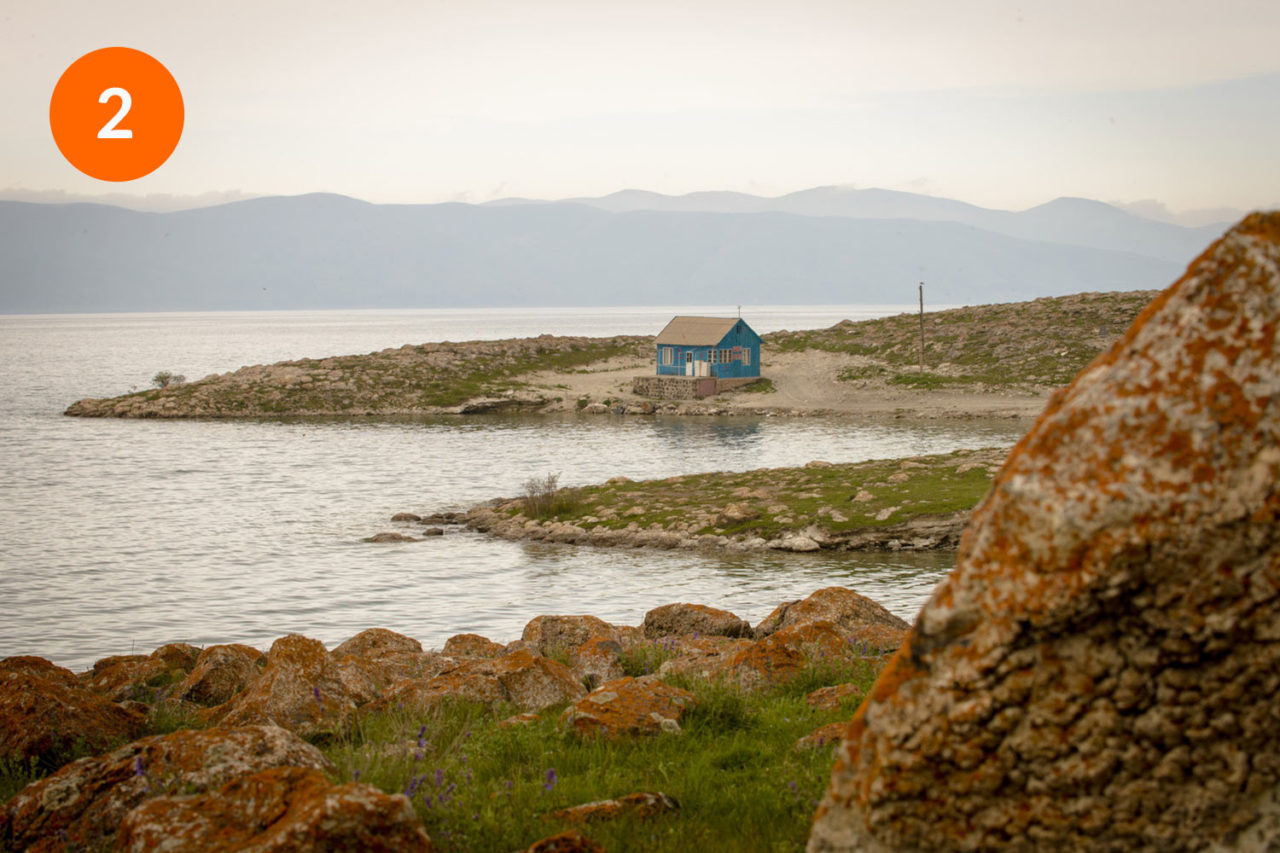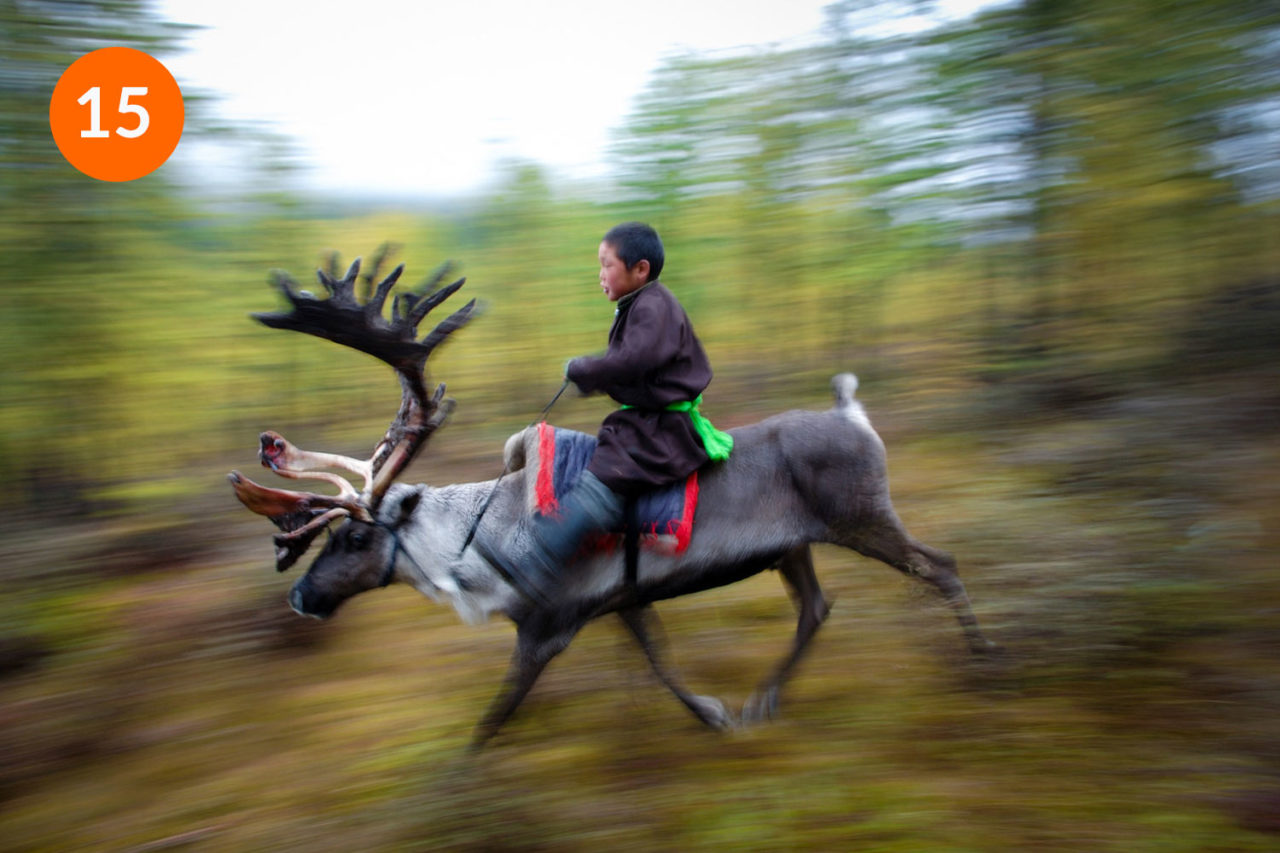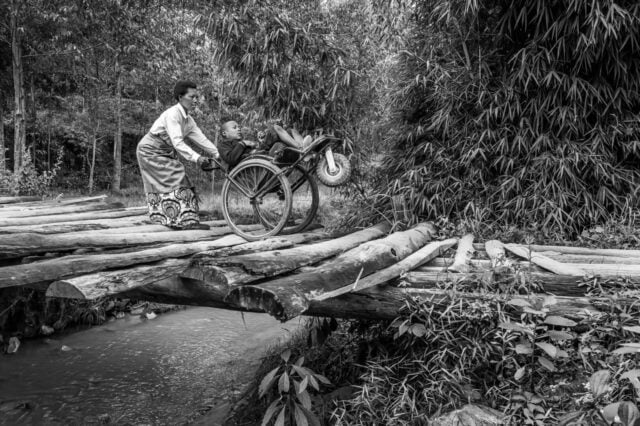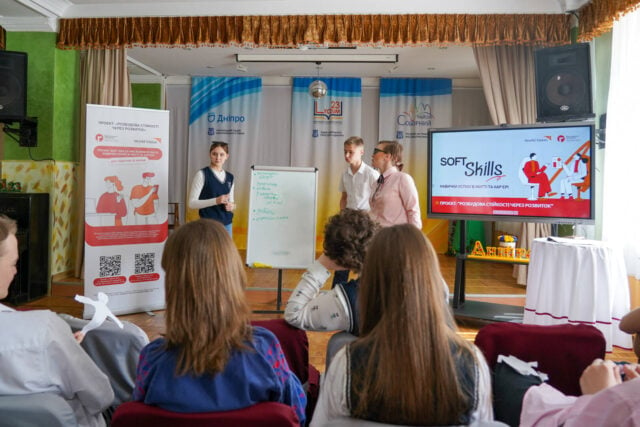Can you guess where in the world each of these 16 photos were taken? Hint: They’re all from places where World Vision works around the globe alongside local staff and partners. Find an answer key at the bottom with links to our country profiles to learn more.
 In this tiny East African nation, World Vision trained farmers to improve their livelihoods by terracing their hillsides to grow crops such as coffee. (©2015 World Vision/photo by Jon Warren)
In this tiny East African nation, World Vision trained farmers to improve their livelihoods by terracing their hillsides to grow crops such as coffee. (©2015 World Vision/photo by Jon Warren)
 A blue cottage has a peaceful view of Lake Sevan in this small landlocked country, where World Vision began work in 1988 after a devastating earthquake. (©2015 World Vision/photo by Laura Reinhardt)
A blue cottage has a peaceful view of Lake Sevan in this small landlocked country, where World Vision began work in 1988 after a devastating earthquake. (©2015 World Vision/photo by Laura Reinhardt)
 A tangle of rickshaws, cars, and pedestrians clog the streets in this nation’s capital, where World Vision started urban sponsorship programs for children in 1997. (©2015 World Vision/photo by Jon Warren)
A tangle of rickshaws, cars, and pedestrians clog the streets in this nation’s capital, where World Vision started urban sponsorship programs for children in 1997. (©2015 World Vision/photo by Jon Warren)
 In this country’s capital, a monument to national hero Skanderbeg presides over the city’s main square. (©2008 World Vision/photo by Jon Warren)
In this country’s capital, a monument to national hero Skanderbeg presides over the city’s main square. (©2008 World Vision/photo by Jon Warren)
 Elephants walking down the street is just a normal day in this South Asian nation whose borders stretch across mountains, desert, and jungle. Since 1953, World Vision has worked here through child sponsorship, disaster relief, and programs to combat child labor and trafficking. (©2012 World Vision/photo by Jon Warren)
Elephants walking down the street is just a normal day in this South Asian nation whose borders stretch across mountains, desert, and jungle. Since 1953, World Vision has worked here through child sponsorship, disaster relief, and programs to combat child labor and trafficking. (©2012 World Vision/photo by Jon Warren)
 The sun sets on the skyline of the capital city of this country, where World Vision is serving some of the more than 600,000 refugees who fled here from neighboring Syria. (©2013 World Vision/photo by Jon Warren)
The sun sets on the skyline of the capital city of this country, where World Vision is serving some of the more than 600,000 refugees who fled here from neighboring Syria. (©2013 World Vision/photo by Jon Warren)
 Snow-covered haystacks are testament to the record cold weather this Eastern European nation received in winter 2011. World Vision’s child sponsorship programs in this area help families keep their children warm with winter clothing. (©2011 World Vision/photo by Laura Reinhardt)
Snow-covered haystacks are testament to the record cold weather this Eastern European nation received in winter 2011. World Vision’s child sponsorship programs in this area help families keep their children warm with winter clothing. (©2011 World Vision/photo by Laura Reinhardt)
 Penguins live at the beach in this African country, where World Vision has worked since 1965. In the last 15 years, child sponsorship and other programs have focused on the continent’s AIDS crisis. (©2008 World Vision/photo by Jon Warren)
Penguins live at the beach in this African country, where World Vision has worked since 1965. In the last 15 years, child sponsorship and other programs have focused on the continent’s AIDS crisis. (©2008 World Vision/photo by Jon Warren)

The lush fields in Antsokia Valley weren’t always so green — a famine that gripped this country in the 1980s left 1 million people dead and the countryside barren. World Vision has worked here since 1971, focused on education, health, and clean water. (©2004 World Vision/photo by Jon Warren)

The golden domes of the Convent of St. Mary Magdalene, as seen from the Mount of Olives, glimmer in this ancient Middle Eastern city. Nearby, World Vision serves thousands of children and their families with health and education programs alongside partnerships with local organizations. (©2011 World Vision/photo by Jon Warren)

High in the Andes Mountains of this country, Uchcoccocha Lake provides nearby communities with plenty of rainbow trout, a local specialty. World Vision helped set up a hatchery with supplies, a boat, and training. (©2008 World Vision/photo by Jon Warren)
 This building silhouette may look like a temple, but it’s a memorial to those killed nearby by Khmer Rouge. World Vision was forced to leave this country in 1975 but resumed its work four years later to help the nation recover from genocide. (©2012 World Vision/photo by Jon Warren)
This building silhouette may look like a temple, but it’s a memorial to those killed nearby by Khmer Rouge. World Vision was forced to leave this country in 1975 but resumed its work four years later to help the nation recover from genocide. (©2012 World Vision/photo by Jon Warren)
 In the heart of Africa, men steer precarious vessels along the Ndjili River to collect sand. This resource-rich country is also one of the world’s poorest, and World Vision has worked here since 1958 to address the root causes of poverty. (©2011 World Vision/photo by Jon Warren)
In the heart of Africa, men steer precarious vessels along the Ndjili River to collect sand. This resource-rich country is also one of the world’s poorest, and World Vision has worked here since 1958 to address the root causes of poverty. (©2011 World Vision/photo by Jon Warren)
 A monarch butterfly rests on vibrant blossoms in this Latin American country, where millions of monarch butterflies migrate during the winter months. Butterflies aren’t the only ones thriving — child sponsorship programs help improve childrens’ health and education. (©2010 World Vision/photo by Jon Warren)
A monarch butterfly rests on vibrant blossoms in this Latin American country, where millions of monarch butterflies migrate during the winter months. Butterflies aren’t the only ones thriving — child sponsorship programs help improve childrens’ health and education. (©2010 World Vision/photo by Jon Warren)
 A reindeer and his rider dash through the forest of this country, where its wide-open steppes earned the nickname “Land of the Blue Sky.” Many families here who herd reindeer benefit from a World Vision project that diversifies their livelihoods by growing vegetables and providing medical and veterinary assistance. (©2006 World Vision/photo by Justin Douglass)
A reindeer and his rider dash through the forest of this country, where its wide-open steppes earned the nickname “Land of the Blue Sky.” Many families here who herd reindeer benefit from a World Vision project that diversifies their livelihoods by growing vegetables and providing medical and veterinary assistance. (©2006 World Vision/photo by Justin Douglass)
 Two women in this southern African nation balance their loads as they walk into the sunset. In 2014, this community was one of 416 across the country where World Vision’s work ensured that every person gained access to clean water. (©2014 World Vision/photo by Jon Warren)
Two women in this southern African nation balance their loads as they walk into the sunset. In 2014, this community was one of 416 across the country where World Vision’s work ensured that every person gained access to clean water. (©2014 World Vision/photo by Jon Warren)
- Rwanda
- Armenia
- Bangladesh
- Albania
- India
- Jordan
- Romania
- South Africa
- Ethiopia
- Jerusalem/West Bank/Gaza
- Peru
- Cambodia
- Democratic Republic of the Congo
- Mexico
- Mongolia
- Zambia
[/ultimate_modal]


